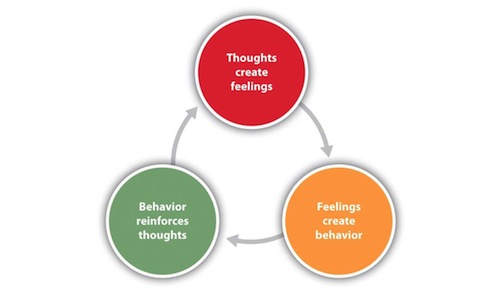Self-awareness is the foundation of good communication including assertiveness and other social skills. Self-awareness begins with understanding the relationships between one’s own thoughts, feelings and behaviours (TFB circle), followed by the regular use of data gathering techniques such as listening to self-talk, observation of one’s thoughts, feelings and behaviours, imagination, and remembering past experiences.

Key instructive techniques used by practitioners to help clients develop self-awareness include: (i) explanation of the thoughts, feelings and behaviours (TFB) circle, and (ii) guided self-discovery or Socratic questioning in order to bring information to awareness and promote reflection and questioning of automatic thoughts and assumptions (Neenan & Dryden, 2004).
In terms of supervised practice: (i) games can be used to practice identification of different types of thoughts (e.g. wants, expectations, judgements) and feelings (e.g. fear, anger, sadness, happiness), (ii) guided imagery can be used to relive past situations or conjure feared events and explore thoughts and feelings; and (iii) role plays of hypothetical scenarios can be used to practice attending to thoughts and feelings and trying out alternative behavioural responses. (see (Bedell & Lennox, 1997; p67-74)).
Feedback around self-awareness will largely involve positive reinforcement for active participation in practice, and affirmation as evidence of increased insight is demonstrated.
Independent practice in the real world can begin with the client attending to thoughts, feelings and behaviours that occur outside of the therapeutic setting. Homework assignments such as thought and feeling diaries are commonly used (Bedell & Lennox, 1997; p74).
Rather than thought and feeling diaries, creative expression such as painting, taking photos or recording performance of a song or video could be useful alternative ways for young people to practice awareness of thoughts and feelings.
Be aware that psychoactive substances have profound effects upon perceptual processes like self-awareness. They can exacerbate cognitive distortions and contribute to symptoms such as paranoia.
Unless otherwise stated these notes are based on (Bedell & Lennox, 1997: Chapter 2).
Social anxiety
- For clients with social anxiety the challenge may not be so much to increase self-awareness as to alter distortions in self-awareness .
- Cognitive-behavioural models of social anxiety propose that self- awareness is distorted in several ways (Hodson, et al., 2008; Rapee & Heimberg, 1997; p742-745). First, the person holds a mental representation of the self as they believe they are viewed by others and this self-image may be excessively negative or may fail to meet perceived standards in particular ways.
- Second, excessive amounts of attention may be focused on the self and this perceived self-image (see Note C2i). Combined with attentional biases towards negative information and distorted assumptions about the standards expected by others, this leads to perceptions of negative evaluation by others.
- The same types of instructive, supervisory practice, feedback and independent practice techniques are used but these are applied to raising awareness of the distortions in self-awareness including automatic thoughts, assumptions, schemas.
- Practice elements from cognitive re-structuring may be needed in addition to basic self awareness skills.
Note C2i Such imbalances in attention are known as information processing biases.
